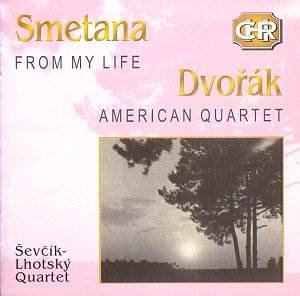In a recent review for the Seen & Heard section
of MusicWeb, I wrote of the Alban Berg’s notable reading
of Smetana’s first quartet. Now here is a recording dating from
way back in 1929 by a string quartet which first played together
in Lvov in 1901 (i.e. over a hundred years ago) as the Czech Quartet
of the Warsaw Philharmonic Orchestra. From 1905 to 1930 they formed
an integrated group, giving their last concert in Slovakia in March
1930.
Their account screams authenticism and dedication
from every note. The intensity of the viola solo in the first
movement penetrates the crackle, survives the somewhat wavery
pitch and emerges from the hiss to make a deep emotional impression.
There is a beautiful sense of flow and inevitability to the whole
experience. Problems do arise in the second movement, admittedly
(scrappy and approximate at times), but the dance character is
maintained and later on, rhythms become infectious.
It is the final two movements that form the dramatic
climax to this piece, with its horrible and visceral depiction
of the composer’s tinnitus. There is no mistaking the drama and
pathos of this event here (around the 3’50 mark).
Why there is a mere
few seconds gap between the two major items on this disc remains
a mystery, then. Dvořák’s brightness bursts onto the unaware
listener, and it takes a few moments to readjust. Still,
once that adjustment has been made, together with a second necessary
adjustment for the plethora of portamenti, there is no
doubt that the melancholy-saturated melodies create their full
emotive impact. Portamenti, perhaps predictably, reach
their climax in the Lento, but it contributes towards an expressive
climax resulting from the players’ respect for the music’s natural
pace and their willingness to give it space to breathe. The final
two movements have a most approachable spring in their step.
The listener is
given a veritable treasure-trove of ‘encores’. The ethos of the
two Dvořák Waltzes is perfectly caught, as is their sense
of fun. Dvořák certainly upstages Oskar Nedbal’s rather syrupy,
soupy specimen, where the portamento disease reaches
epidemic proportions (be warned:
to a modern pair of ears this may easily sound like parody). Nedbal
was a pupil of Dvořák’s at the Prague Conservatory and became
the violist in the Czech Quartet (1891-1906) and conductor of
the Czech Philharmonic Orchestra (1896-1906). The waltz
comes from one of his operettas (he also wrote ballets). Mercifully,
it only lasts for four minutes, before the quartet moves on to
the Scherzo by the quartet’s own viola player. It is sprightly
and full of daylight, exactly the type of piece this quartet seems
to excel at.
Very strongly recommended, then. The musical
qualities far outshine the concessions one might have to make
for the condition of the original sound sources and the pitch
variations. And don’t forget that there is much fun to be had
here, too!.
Colin Clarke
